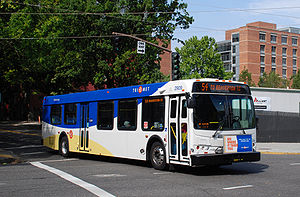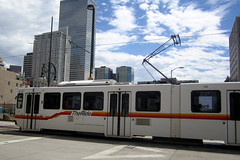| English: by me UTA bus (Photo credit: Wikipedia) |
| English: Bus 2909 of TriMet, the public transit agency in Portland, Oregon, is a 2009-built New Flyer D40LFR. It is pictured on Harrison Street at 4th Avenue in downtown Portland, outbound on route 54 to Beaverton Transit Center. (Photo credit: Wikipedia) |
| Denver - CBD: RTD Light Rail (Photo credit: wallyg) |
Denver RTD
Grade: F
Denver RTD gets the worst grade for customer service. My experience started when I flew into DIA for a meeting and took a RTD bus and light rail to my motel. I boarded one of their MCI commuter cruisers with an all day, all zone pass which I purchased on-line. The driver has to punch the day pass for it to be valid, well the driver did and punched the wrong day. Unfortunately the drivers do not carry day passes so when we got to the light rail station I had to purchase another day pass.
First of all I was not mad at the driver and when I talked to Denver RTD customer service I did not mention which bus or time that it happened. A couple of weeks, that's right weeks after I talk to them about the day pass they send me a nasty email saying basically too bad, not our problem. The email was extremely unprofessional and showed a lack of customer care by RTD.
Portland TriMet
Grade: C
I have been riding TriMet for about a year now since moving here to Portland. For the most part most of my trips are pretty uneventful except for the random person that has to talk on their cell phone way too loud telling the other person about their sex life and so on. However, I have had two experiences with TriMet operators in which I took up an issue with their customer service department. I should point out that I have also sent in three commendations for drivers also so I am not only complaining, but also commend those that are excellent in their jobs.
In both incidents I got a email from a customer service rep that said sorry you had an issue and said the driver would be talked to. I will say that both letters were written individually and not form letters which I gives points to TriMet. TriMet does the basics in good customer service, nothing more so it gets a passing grade.
Salt Lake City Utah Transit Authority
Grade: A
In my time riding UTA, I only one time sent in a complaint. That day I went to take one bus to a Park N Ride lot to catch a second bus. It was daylight out so that cannot be used as an excuse. The driver of the first bus passed me right on by didn't even bother to slow down. Immediately behind him was another bus deadheading to the Park N Ride lot. This driver hit is breaks but then kept on going. I then waited for the next bus to come along. Because the next was supposed to do a loop before heading to the Park N Ride lot I would miss my next bus. However, the driver of the next bus went ahead and dropped me at the Park N Ride Lot so I wouldn't miss my next bus.
The customer service person at UTA offered me two free day passes (since at the time I was not riding on a daily basis so I didn't need the discount on a monthly pass). Of course I didn't complain to get the free day passes and never sent in another complaint. However, UTA did the best job of taking care of the customer and ensuring they will be happy with UTA service.
You can clearly see why UTA gets the best grade here. Some would argue that they should not waste the money trying to please a dissatisfied customer however, that response would be narrow minded. Transit systems need to work on their customer service skills just like any other company that provides a service and deals with passengers every day of the week.
















